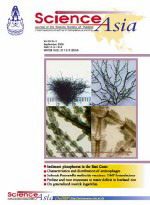ThaiScience
ThaiScience
SCIENCE ASIA
Volume 46, No. 01, Month FEBRUARY, Year 2020, Pages 80 - 86
Polycyclic aromatic hydrocarbons (pahs) in surface soil from the guan river estuary in china
Yingpeng Yua, Xiaoxiang Sun, Lili Zou, Huabing Zhang, Yuqing Liu, Min Liu
Abstract Download PDF
To analyse the distribution characteristics, potential sources and health risks of PAHs in the surface soil of the Guan River Estuary Industrial Area, 30 samples along the Guan River were collected. Sixteen types of PAHs were detected by gas chromatography-mass spectrometry (GC-MS). The results showed that the total content of the 16 PAHs (Σ16PAHs) ranged from 1212.8-12264.5 ng/g, and the arithmetic mean and median were 3504.8 ng/g and 2396.5 ng/g, respectively. The concentrations of 7 carcinogenic PAHs (Σ7carPAHs) ranged from 546.1-5742.3 ng/g, accounting for 34-54% of the Σ16PAHs. The pollution of the PAHs was intermediate compared with that of other industrial areas in China. Fluoranthene, pyrene and benzo[a] pyrene (BaP) are the main monomer PAHs. There was a weak positive correlation between the total organic carbon and the PAHs, and a negative correlation between the PAHs and the pH was found. The characteristic ratio and principal component analysis (PCA) show that the PAHs mainly come from combustion sources, especially the combustion process of coal and coke from industrial areas. The TEQBaP (toxic equivalency quantity relative to BaP) concentrations of 7 types of carcinogenic PAHs accounted for 99% of the Σ16TEQBaP. According to the Canadian soil environmental quality standard, 87% of the sampling site?s PAH pollution values exceeded the safety value, suggesting that there is a potential ecological risk in the Guan River Estuary industrial area.
Keywords
Guan River Estuary, polycyclic aromatic hydrocarbons (PAHs), pollution level, health-risk assessmentSCIENCE ASIA
Published by : The Science Society of Thailand
Contributions welcome at : http://www.scienceasia.org/
